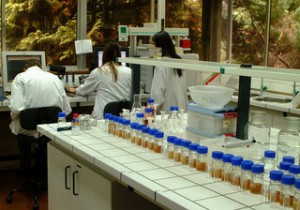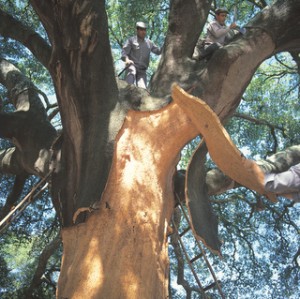Have perceptions of TCA improved in a decade?
Have the investment and new product development measures taken by cork manufacturers during the last decade to better control TCA (the chemical that causes musty, mouldy taint in wine had any real impact on our perceptions of cork as an effective stopper?

Lab research
It was Dr Christian Butzke, president of the American Society of Enology and Viticulture, (ASEV), who wrote in 2009, that TCA was no longer a major problem for the USA wine industry. As chairman and chief judge of the Indy International Wine Competition, he reported that less than 1% of the wines entered were noticeably corked.
Going some way to achieve this redefining position for cork closures has been the California-based Cork Quality Council (CQC). Before CQC members (cork manufacturers and suppliers) accept any cork lot into stockholding, samples are sent to third-party ETS Laboratories for GC/MS analysis (gas chromatography / mass spectrometry) of TCA. They have reported an 80% decrease in the incidence of TCA contamination since 2002.
Since 2007, technical corks are also systematically tested, and reveal remarkably similar results to single piece stoppers. Peter Weber, the director of the CQC estimated “that our group now supplies about 80% of USA corks.”
Weber explained the early quick win for the CQC “When we first started chemical testing for TCA we enjoyed very quick improvement. Most of which was because we could now see what sources were supplying “good” corks. It was easy to instruct the manufacturers to redirect their purchases away from [less good] suppliers. We probably achieved a 50% improvement from this type of adjustment alone.” As manufacturers increasingly used high-tech equipment, the pre-screening process showed continued improvement.
On the other side of the pond data is rarer, and an almost visceral mistrust of the cork industry’s ability to put its house in order appears to have developed in the past decade.

Cork harvest from tree
The picture for cork closures is also now blurred because a lot of mainstream merchants and big retailers moved away from cork-based stoppers into either or both synthetic and screwcap. Bottle Green’s wine director Nick Butler said “we have reduced natural cork closures in the wines we sell to less than 20%.” It’s a similar picture at Alliance Wines, where business development director Fergal Tynan MW said “we moved almost all of our own production wines to screwcap some time ago, This remains our preferred closure, far from perfect but offering the best overall solution at the moment.”
Whether retailers initiated this trend is a mute point. Sainsbury’s winemaker Clem Yates said “over the past five years most of Sainsbury’s own label wines were either under synthetic or screwcap with little natural cork used in the range.” Direct Wines’ product manager, Martin Campion echoed this approach, saying “we are buying more wines under screwcap than ever before.” But added “we will continue to take the more classic wines under natural corks,”
Despite this loss of market share by cork stoppers, within the cork share of market there appears anecdotally to have been modest improvement, though monitoring of customer complaints is unreliable, and many retailers don’t attribute credibility to these data. Thierry’s winemaker and quality manager, Jeneve Williams, urged caution regarding false positive reporting of customer complaints, saying “cork taint is still an issue … though products such as Diam have made a difference to the incidence rate along with the efforts of the cork industry to improve quality of production processes”.
Thierry’s Burgundy supplier Mommessin supported a slight improvement. Their quality manager, Paul Correia said “‘we still do in-house batch testing on the corks because the R&D programs implemented by cork suppliers started only 10 years ago. The rate of cork taint has decreased – I rejected 4 lots in 2009, 4 in 2008 but 14 in 2007, so the quality has improved but cork suppliers have more to do.”
This leaves anecdotal evidence largely coming from tastings and observed experience, and carefully monitored wine competitions provide some clues. Thomas Costenoble, director of the Concours Mondial de Bruxelles, where taint issues have been analysed since the competition started in 1994, said cork “problems decreased significantly, however we cannot say that TCA disappeared. This year 120 samples came back to the preparation room (~1.7% of the total) [all faults: TCA, oxidation, reduction, re-fermentation etc]. No more than 66 samples were really suspected of cork problems (0.9%).”
The International Wine and Spirit Competition (IWSC) have only more recently been measuring faults. Competition director Frances Horder, said “we have measured requests for a replacement bottle, by closure type, for the last 3 years, and added fault types last year. In 2007 and 2008, 8.3% of bottles with natural cork were replaced, falling to 7.2% in 2009. Just under half of these were identified as due to TCA, so 3 to 4% of the total. … anecdotally this year also looks better.” So significantly different figures, but a slight downward trend.
This is confirmed by the more traditional merchant sector of the UK market. Patrick Sandeman of Lea and Sandeman said “I would confidently say that we have had far less of a general problem with corked wines over the past decade because the cork producers have finally realised that they had a problem and it needed sorting.” Anecdotally, at a recent Lea and Sandeman tasting, Sandeman said “of the 130 or so wines which we opened, of which upwards of 80% were under cork, we only came across one bottle which was very definitely corked.” Elsewhere, Joel Lauga sales director at Great Western Wine and Ewan Murray, the head of tastings, events and PR at the Wine Society have guestimated reductions in cork taint from 10 to 20%.
Some positive stories have emerged. Yates said “we have recently reviewed the Sainsbury’s closure policy and we feel that the risk of TCA has decreased, so we’re in the process of working with Amorim to use a more sustainable FSC (Forestry Stewardship Council) natural cork in a wider range of own label wines.”
One or two others have revised their views on cork. Sandeman said “a decade ago we were very much in favour of Stelvin, but our attitude has changed back in favour of cork for many reasons – aesthetic, environmental, and quality. Cork will always be the best closure so long as it works, and increasingly it does so.” Waitrose buyer Andrew Shaw’s views on cork closures have “gone full circle – it’s once again seen to be the best closure if managed correctly”, but 60% of Waitrose’s sales are of screwcapped wines, so “reduction [a different type of wine fault] is a potentially greater concern.”
Despite the promising news, hesitancy and caution remained the watchwords of the trade, with Lauga saying “the rate of infection, although better, is still too high to regain wide confidence especially for new drinkers. We still rate cork closures high risk.” Yates was similarly strident, saying cork taint “seems to have reduced dramatically from recent years, but there are still very dangerous levels of TCA which just dumb the fruit and are not obvious even to the trade so therefore still have a large potential to negatively influence the consumer.”
Cork taint is unequivocally still an issue. Butler said “why invest so much in the wine, packaging, marketing and then possibly risk it all with a risky closure. Certainly my perception is that the cork manufactures have improved their systems, supplying better cork, more consistently BUT the vulnerability to random TCA issues persists.”
The message is clear from the UK. The cork industry still has plenty of work to do.



